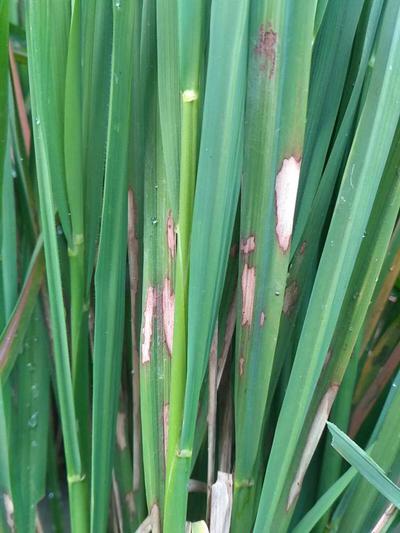Rice Sheath Blight
Rhizoctonia solani
Fungus
In a Nutshell
- Oval, green to grey water-soaked lesions on stalks.
- Irregular grey to white lesions with brown margins on leaves and stalks.
Can also be found in
Symptoms
Initial symptoms of the disease are lesions on stalks (sheaths) near the waterline. These lesions are oval, greenish-grey, 1-3 cm long and water-soaked. These lesions grow irregularly and turn grey to white with brown margins. As the disease progresses, the upper parts of the plant are infected. On these parts, rapidly growing lesions appear and the whole leaf brightens. This can result in the death of the leaf and the whole plant. Furthermore, fungal pustules form on the plant surface.
Recommendations

Organic Control
Unfortunately, no effective biological control methods are available at this time.

Chemical Control
Always consider an integrated approach with preventive measures together with biological treatments if available. To prevent infection, use the following fungicides: hexaconazole 5EC (2 ml/l) or validamycin 3L (2ml/l) or propiconazole 25 EC (1ml/l) or trifloxystrobin + tebuconazole (0.4g/l). Alternate the sprays twice at 15 days interval.
What caused it?
Optimal conditions for rice sheath blight are high temperatures between 28 and 32°C, high levels of nitrogen fertilizer and high relative humidity of 85-100%. Especially during the rainy season, the risk of infection and spreading of the disease is high. Close canopy favors humid conditions and contact. The fungus survives in the soil for several years as a dormant sclerotium. It floats to the surface when sites are flooded. Once in contact with a rice plant, the fungus enters the leaf sheath, starting the infection process.
Preventive Measures
- Make sure to purchase healthy seeds, and from certified sources.
- Use varieties resistant to this disease, if available in your area.
- Plan a late planting of your rice transplants.
- Reduce sowing rates at planting.
- or keep wider space between plants.
- Use a balanced fertilization plan adapted to the crop, and with split nitrogen applications.
- Maintain optimum density of crop establishment (direct seeding or transplanting).
- Control host weeds, especially on the bunds.
- Ensure good drainage of the field early in the season to avoid epidemic proportions.
- Destroy stubbles and other plant residues after harvest.



